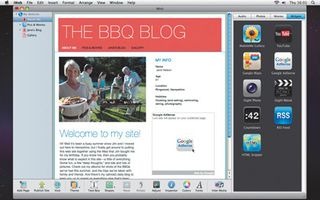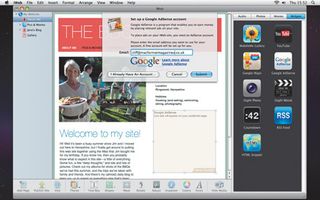Guide to iWeb: tips and tricks you need to know
Design an entire website in a matter of minutes
You don't need to be a big corporation to earn cash from your site

Try to imagine a 21st-century version of the rags-to-riches tale: a smart guy/gal has an idea for a website and sets the whole thing up on a laptop in their back bedroom. Five years later they sell the website for a gazillion dollars and then sit back and wait for Brad Pitt/Angelina Jolie to play them in the Hollywood version of their life story.
Of course, it might be a bit tricky to come up with an idea that Facebook, Google, Twitter and all the rest have somehow overlooked (but not impossible – after all, nobody saw Twitter coming along, did they?). But that doesn't mean you can't still make a bit of money with your website from time to time.
Get selling
The most obvious way, of course, is to start up a website for a new business that is selling a particular product or service. On a smaller scale, you could try setting up shop on eBay and flogging the contents of your loft.
However, iWeb wasn't really designed for business use, and most iWeb users will be home users who just want to set up a personal website as a hobby. Even so, it is still possible to 'monetise your online digital assets' – or, in plain English, to make a few bucks by selling advertising.
You don't have to be a massive website with millions of visitors, such as Google or Yahoo, in order to sell advertising. In fact, selling the advertising space is actually the easy part.
Get daily insight, inspiration and deals in your inbox
Get the hottest deals available in your inbox plus news, reviews, opinion, analysis and more from the TechRadar team.
Instead of getting on the phone and trying to sell a few ads to local businesses yourself, you can just sign up for Google's AdSense program, which actually handles the tedious business of selling the ad space for you. And, just to make things even easier, Apple even includes a special AdSense widget in iWeb to help you out.
Like all the other widgets in iWeb, the AdSense widget can just be dragged and dropped onto your web page with a quick flick of your mouse, so you don't need any special technical know-how in order to insert the ads into your web page.
Earning from eyeballs

You do have to do a bit of work, though, if you want AdSense to work successfully for you. AdSense only starts to send you payments once you pass a certain threshold – which will depend on the number of people who visit your website and the numbers who also go on to click on the ads and visit your advertisers.
So you need to make sure you have a steady stream of people coming to your website to provide an audience for your ads – and preferably people who have an interest in a specific subject or activity, as that will make it easier to target them with relevant adverts.
If your website is little more than an online diary, where you post a few pics from last weekend's BBQ, then you're not going to attract much of an audience beyond your own family and friends. And that, in turn, means you're not going to generate much money from online ads.
Blog it!
A better option – and one that has started many a prosperous career on the web – is to create a blog. Instead of just writing about last weekend's BBQ, you could throw in a steady stream of recipes and cooking tips, and maybe the odd review of new BBQ equipment - and hey presto – you've got a blog!
A number of blogs have been turned into successful books, films or TV programmes – the most recent example being Belle Du Jour – while many other bloggers have been successful enough to turn their blogs into profitable full-time jobs. Again, though, it can't just be a blog that's only of interest to you and your friends.
But if you can write intelligently about a specific subject or activity that attracts a wider audience, then you're in with a fighting chance of attracting enough 'eyeballs' to get the ad revenue flowing.
The trick with blogging is to find a niche. You might think that topics such as stamp-collecting or Victorian moustache-trimming devices are obscure subjects that only appeal to a few people, but don't forget the internet is a worldwide medium. Whatever obscure subject you choose to blog about, the chances are that there are tens of thousands – if not millions – of people around the world who are interested in that subject.
And if you can get just a few thousand of those people checking in on your blog on a regular basis, then you've got the makings of a respectable revenue stream (see, you're picking up the marketing jargon already).
Sometimes you can even focus on a niche-within-a-niche. There are thousands of bloggers out there who write about digital photography. But if you were to write specifically about cameras and lenses that are particularly suited to sports photography, then you could still attract a large and devoted specialist audience. And the fact that those people have a strong interest in that particular subject also makes them a better target for ads that focus on that subject.
This means that the 'eyeballs' are more likely to translate into clickthroughs when people click on the ads, which in turn generates more ad revenue.
Know your stuff
In order to create a successful blog you obviously need to know a fair bit about your chosen topic, and to be able to write about it in an intelligent and interesting manner. You also need to update your website regularly – daily if possible, but certainly weekly. If people come to your website to read the latest news about Victorian moustache-trimmers and they see that your blog hasn't been updated in the last six months, then they're not going to come back.
The most important thing, though, is to blog about something you're really interested in. If that enthusiasm comes through in your writing then you're already halfway to attracting a regular audience, who will enjoy coming back to your blog week after week and help to keep the ad sales ticking over.
How to make sense of AdSense
1. Easy ads

Getting ads onto your website is normally hard work once you start trying to sell them and figuring out the technicalities of how to put them onto web pages. But iWeb makes it easy – just drag and drop the Google AdSense widget onto a page with your mouse.
2. Create your account

You are then prompted to enter your email address in order to set up your personal Google AdSense account, or to enter details of an existing account. If you're new to AdSense there's a 'Learn More' option so you can read more about the options that are available.
3. Making money

The AdSense widget allows you to specify the size and colour of the ads so that they don't clash too much with your page. The amount you earn depends on the ad, the number of people that view it, and the number of clickthroughs when people click the ads.
Cliff Joseph is a former Editor of MacUser magazine, and a freelance technology writer with 30 year’s experience in the industry (and old enough to remember when Apple was close to going bust…).
His first job involved using Macs for magazine sub-editing and typesetting, which led to the realisation that these computer-thingies might actually turn out to be useful after all. After a few years specialising in the Mac side of the market, he went freelance and embraced the wide world of digital technology, including Windows PCs, digital audio and hi-fi, and networking. Somewhere along the line he also developed a bit of a gaming habit and has stubbornly waved the flag for Mac gaming for far too many years.
